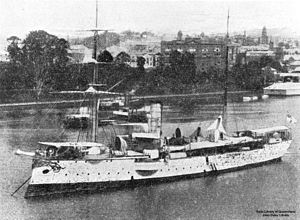 Cormoran in Brisbane, Australia
| |
| History | |
|---|---|
| Name | Cormoran |
| Namesake | Great cormorant |
| Laid down | 1890 |
| Launched | 17 May 1892 |
| Commissioned | 25 July 1893 |
| Fate | Scuttled at Tsingtau, 28 September 1914 |
| General characteristics | |
| Class and type | Bussard-class unprotected cruiser |
| Displacement | |
| Length | 82.6 m (271 ft 0 in) |
| Beam | 12.7 m (41 ft 8 in) |
| Draft | 4.42 m (14 ft 6 in) |
| Installed power |
|
| Propulsion | |
| Speed | 15.5 knots (28.7 km/h; 17.8 mph) |
| Range | 2,950 nmi (5,460 km) at 9 knots (17 km/h) |
| Complement |
|
| Armament |
|
SMS Cormoran ("His Majesty's Ship Cormorant")[a] was an unprotected cruiser of the Bussard class, the fifth member of a class of six ships. She was built for the Imperial German Navy for overseas duty. The cruiser's keel was laid down in Danzig in 1890; she was launched in May 1892 and commissioned in July 1893. Cormoran was armed with a main battery of eight 10.5-centimeter (4.1 in) guns, and could steam at a speed of 15.5 knots (28.7 km/h; 17.8 mph).
Cormoran spent the majority of her career abroad, usually in Germany's South Pacific colonies in the Samoan Islands. Her duties there typically consisted of survey work and suppressing colonial unrest. She briefly cruised in South African waters in late 1894 and early 1895 before steaming to the Pacific. She participated in the seizure of the Jiaozhou Bay Leased Territory in the Shandong Peninsula in China in 1897. Cormoran returned to Germany in 1903 and was modernized in 1907–08. The following year, she returned to the South Pacific, where she remained until the outbreak of World War I in August 1914. Docked in Tsingtau for repairs at the onset of hostilities, she was unable to actively take part in the fighting. She was therefore disarmed and scuttled in the harbor; her guns were used to strengthen the defenses of the port.
Cite error: There are <ref group=lower-alpha> tags or {{efn}} templates on this page, but the references will not show without a {{reflist|group=lower-alpha}} template or {{notelist}} template (see the help page).